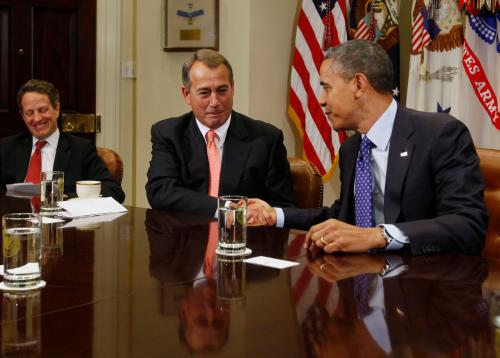It is almost 22 years to the month since Representative Barber Conable Jr. strode to the floor of the House to defend a carefully constructed plan to save Social Security. Mr. Conable, a moderate New York Republican with whom I then worked, spoke with characteristic understatement. “This is not a work of art,” he told a packed chamber. “But it is artful work.”
He was right. The $168 billion package eased the program through a turbulent period, and 1983 marks the last time Congress cut Social Security benefits, raised taxes and lived to tell about it. Before drawing too much inspiration from this history, however, we should recognize that this rescue was anything but assured when Mr. Conable and the other members of the bipartisan National Commission on Social Security Reform began work under the leadership of Alan Greenspan in February 1982.
Then as now, a president was ready to invest his political capital in Social Security reform. Despite his best efforts to convince the public that Social Security was going broke, Ronald Reagan got exactly nowhere. In May 1981 his budget director, David Stockman, proposed a deep cut in the early-retirement benefit available at age 62; in July there was the suggested elimination of the $122-a-month minimum benefit for the poorest beneficiaries; and in September word leaked out that Mr. Reagan was considering a three-month freeze in the annual cost-of-living increase.
With his public approval sagging under opposition to all these proposals, Mr. Reagan did what any beleaguered president would do: he pulled his foot off the third rail of the political subway and proposed a bipartisan national commission to study the issue. Scheduled to report by January 1983, after the midterm elections, the 15-member commission would, with luck, give the president time to recover before the 1984 campaign.
Then as now, there was little agreement that the program was actually broken. Republicans used worst-case economic assumptions to paint the most draconian future imaginable – and then best-case assumptions to sell their solutions. Democrats, in turn, used their own projections to minimize the Social Security problem, and the worst-case numbers to illustrate the impact of any benefit cuts.
Then as now, there was intense conflict on how to fix the program. As expected, Republicans said the best way to rescue Social Security was to reduce benefits, while Democrats sought to give the program breathing room by raising taxes.
Finally, then as now, Republicans worried about how Social Security would affect the midterm elections. Their concern was justified. With Social Security as the centerpiece of their “It’s not fair … It’s Republican” advertising campaign, Democrats added 26 seats to their already substantial majority in 1982.
So much for the parallels between then and now. The 1983 rescue was rooted in four conditions that do not currently prevail.
First, there was a real and pressing deadline for action in 1983 that simply does not exist today. Without action by March or April 1983, the Social Security trust fund would have started to run a slight deficit by midsummer. Social Security would not have literally gone bankrupt, but there would have been a slight disruption in check processing until the needed revenue dribbled in.
Second, both sides in the 1983 debate eventually agreed on a single estimate of the size of the problem – a consensus that seems well out of reach today. “Everyone is entitled to their own opinions,” Senator Daniel Patrick Moynihan told his fellow commissioners as they set the targets for compromise only days after the 1982 midterm elections. “But not to their own facts.”
Third, negotiators had the political cover to form a consensus that would be hard to build in today’s 24-hour news cycle. Although the commission is often credited for the 1983 Social Security rescue, the hard bargaining was done by a secret “gang of nine” that met irregularly during the first two weeks of January at the Foxhall Road home of James Baker, then the White House chief of staff. The members reached a final agreement one early afternoon in January 1983, then watched the Redskins defeat the Vikings in the N.F.L. playoffs as they waited for final approvals from the president and speaker of the House.
Fourth, both sides agreed to mutual sacrifice, a concept that has yet to surface in the current conversation. Democrats accepted a six-month delay in the annual cost-of-living adjustment and the increase in the retirement age, while Republicans accepted a faster-than-planned rise in payroll taxes and a substantial tax increase on the self-employed. The two sides closed the deal by subjecting up to half of Social Security benefits to income taxes for higher-income beneficiaries, a provision that allowed Democrats to say Republicans had passed a tax increase and Republicans to say Democrats had agreed to a benefit cut.
This agreement was rooted in a common willingness to solve the problem regardless of the political consequences. Republicans gave up their effort to reduce the public’s dependency on Social Security, while Democrats gave up the one campaign issue that might have slowed Mr. Reagan’s easy run to re-election in 1984.
It is hard to imagine how a similar package could emerge from today’s highly polarized process. Yet, as the 1983 rescue showed, Congress and presidents can take action when they are forced into up-or-down votes on urgent problems. The key is deciding just how urgent a problem is.









Commentary
Op-edThe Crisis Last Time: Social Security Reform
March 5, 2005